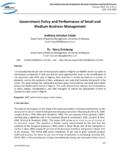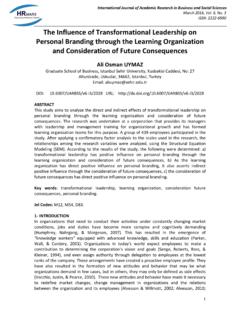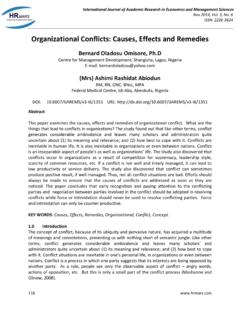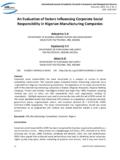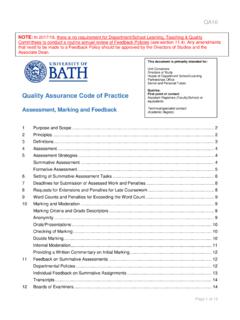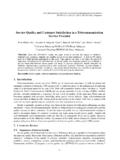Transcription of Service Quality and Customer Perceived value in …
1 International Journal of Academic Research in Business and Social Sciences December 2013, Vol. 3, No. 12 ISSN: 2222-6990 529 Service Quality and Customer Perceived value in Software Companies of Iran Ahmad Jafarnejad University of Tehran, Iran Hessam Shafie (Corresponding Author) University of Tehran, Iran DOI: URL: Abstract Service Quality and Customer Perceived value are significant for companies since they are highly correlated with loyalty, retention, and repurchase in a way that they all contribute to increasing profitability. This study aims at presenting a conceptual model for Service Quality (SQ) and Customer Perceived value (CPV) in six large software companies in Iran. To do so, after reviewing the related literature, the effective factors in the SQ and CPV were identified.
2 Then, questionnaires were distributed among the customers of the company and 354 completed questionnaires were collected. Next, Factor Analysis and Structural Equation Modelling were used to find the relation between SQ and CPV; as a result, the proposed model was extracted. Our findings indicated that there is a significant and positive relationship between SQ and CPV in six large software companies in Iran. Keywords: Service Quality (SQ), Customer Perceived value (CPV), Structural Equation Modelling (SEM), Software Companies. 1. Introduction It is very important for the Service industry to improve Service Quality . The core value provided by the Service industry to customers includes not only the uniqueness of products, but also the variety of factors involved in Service processes (lin, 2007).
3 Superior Service Quality enables a firm to differentiate itself from its competitors, to gain a sustainable competitive advantage, and to enhance efficiency .The benefits of Service Quality include increased Customer satisfaction, improved Customer retention, positive word of mouth, reduced staff turnover, decreased operating costs, enlarged market share, increased profitability, and improved financial performance (Ladhari, 2009). The evaluation of Quality for services is more complex than that for products because they are heterogeneous, perishable and intangible. In addition, production and consumption are inseparable (Frochot and Hughes, 2000). This subject becomes more complex when factors such as type of Service setting, situation, time, need, etc.
4 Come on the scene since the Service Quality outcome and measurement are dependent on them. Moreover, even the Customer s expectations towards a particular services are also changing with respect to factors like time, increase in the number of encounters with a particular Service , competitive environment, etc. These demands for a continuous effort to learn, validate and modify the existing concepts of Service Quality (Seth et al, 2004). International Journal of Academic Research in Business and Social Sciences December 2013, Vol. 3, No. 12 ISSN: 2222-6990 530 Also, recognition of Customer Perceived value has been pointed out as one of the most important measures in gaining a competitive edge (Parasuraman, 1997) and a key factor in strategic management (Burns and Woodruff, 1992).
5 Although a plethora of research has been done on Service Quality in the context of Customer services, business-to-business services have rarely been addressed(Woo and Ennew, 2005).Paulssen and Birk(2007), further state that vast majority of Service Quality and Customer Perceived value research has been done in the business-to-consumer context. As a result, this area of research seems to be in dire need of empirical research in the context of business-to-business. Taking these lines of research into account, this study set out to investigate the interactions between indicators of Service Quality (SQ) and Customer Perceived value (CPV) in six large software companies in Iran.
6 To this end, after reviewing the literature and identifying the indicators, a questionnaire among customers was distributed and 354 questionnaires were completed. Eventually, Structural Equation Modeling (SEM) was utilized. Findings attempted to shed some light on the relationship between Service Quality (SQ) and Customer Perceived value (CPV) in software industry. 2. Literature review Service Quality (SQ) Quality , as a driver of competitive strategy, is largely a performance assessment and it relies on evaluation of performance excellence criteria (Oliver, 1994). Many Quality frameworks have been introduced for strategic purposes (Ma et al, 2005). For instance, Garvin developed an eight-dimension Quality framework (Garvin, 1987).
7 Quality frameworks have been designed primarily for physical goods; when applied to Service settings, difficulties arose because of the special characteristics of services: Intangibility: Service cannot be counted, measured, inventoried, tested, and verified in advance of sale; Heterogeneity: it is difficult to assure consistency of behavior from Service personnel; Inseparability: one cannot separate consumption from production; (Ma et al, 2005). Service Quality is an important issue in Service management (Clottey et al, 2008); besides, with the development of the Service sector, the notion of Service Quality has become increasingly significant (Ma et al, 2005). In the related literature, Plausible definitions for Service Quality have been suggested, Parasuramanet al (1988), define Customer Perceived Service Quality as a global judgment or attitude related to the superiority of a Service relative to competing offerings.
8 According to Bitner and Hubbert (1994), it is the Customer s overall impression of the relative inferiority/superiority of the organization and its services. Zeithaml and Bitner (1996) see Service Quality as the delivery of excellent or superior Service relative to Customer expectations. Gronroos (1984), depicts the concept as the outcome of an evaluation process, where the consumer compares his expectations with the Service he perceives he has received (p. 37). Among others, two main theoretical constructs seem outstanding. The European school of thought led by the work of Gronroos (1984), undoubtedly serves as the pivot on which studies on the conceptualisation of Service Quality turn. This school of thought put forward that customers perceive Service Quality from two viewpoints: the technical Quality and the functional Quality of the Service .
9 Technical Quality has to do with the question if the Service meets customers expectations. The functional Quality measures how customers perceive the production and delivery of the Service . While this dichotomy is technically viable, both are required to influence customers Service Quality evaluations and loyalty behaviours (Richard and Allaway, 1993). The European school has been criticized on the grounds that it excludes the Service physical environment. The other conceptualisation of Service Quality - the American International Journal of Academic Research in Business and Social Sciences December 2013, Vol. 3, No. 12 ISSN: 2222-6990 531 school of thought hinges upon the work of Parasuraman et al.
10 , (1985, 1988 and 1994) and Parasuraman et al. (1991). This view has been adopted by a number of scholars researching Service Quality . Parasuraman et al., (1985 & 1988) conceptualised Service Quality as the overall assessment of the difference between perception and expectation of Service this model, which has been regarded as the most prominent, through a series of focus group sessions, 10 dimensions of Service Quality that are generic and relevant to services in general were uncovered. These dimensions are tangibles, reliability, responsiveness, communication, credibility, security, competence, courtesy, understanding the Customer and access. In later studies, the dimensions have been condensed into five ones by using factor analysis: tangibles, reliability, responsibility, assurance and empathy.


